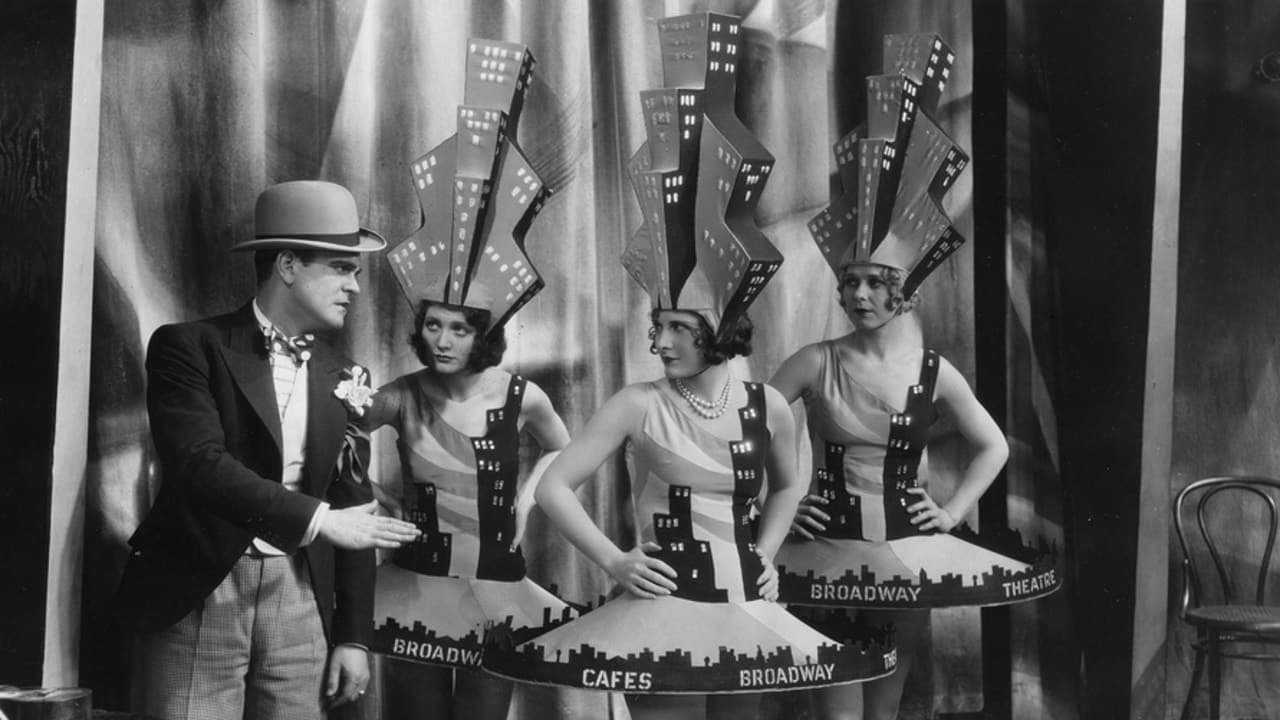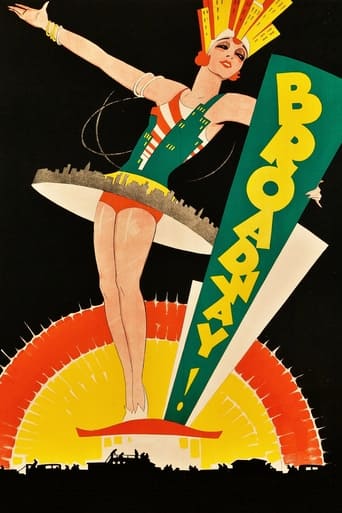

Well Deserved Praise
... View MorePurely Joyful Movie!
... View MoreI didn’t really have many expectations going into the movie (good or bad), but I actually really enjoyed it. I really liked the characters and the banter between them.
... View MoreIt's a good bad... and worth a popcorn matinée. While it's easy to lament what could have been...
... View MoreBroadway represents what you practically picture when you think of the typical, or in this case perhaps proto-typical or quintessential or one of those highfalutin terms - of the late 20's/early 30's back-stage musical. This isn't to say that it's entirely like something of the quality of, say, 42nd Street or other Busby Berkley musicals, it doesn't quite have that standard of artistry. But it has the edge, via director Paul Fejos, of containing a certain excitement to its plot by it being really kicked off by a behind- closed-doors murder (let's just take him out as if the guy is drunk, even though he's dead) and it has a good gangster edge to it. Maybe not fully that, but it has that criminal side that makes it more than just the standard back-stage drama. There's some romance too, between one of the guys that I think runs the show or runs the club or something like that, and one of the dancing/singing girls for the show. It feels like we know it will have a tragic outcome in some way or another, but we can't be totally sure how it will unfold (one may have an idea, and you may be correct, but who will eventually take out who turns out to be a real surprise). The main mark against it is that some of the dialog and performances haven't aged too amazingly, but then context is in order: this was one of the earliest tries at not just a sound picture but a sound musical, and in that sense it's phenomenally directed by nature of the movement of the camera. Of course one can tell when at certain times it has to stop dead and the actors are there on set for the sake of the microphone getting their dialog as carefully as possible. Also, as one might expect, some (or many) of the performances are more geared for the stage, how the dialog is spoken especially. What elevates it is the joy in Fejos's direction and that he doesn't get *bad* performances exactly out of his players (at worst they're just mediocre or forgettable). He also brings a certain authenticity, or just a 'movie' authenticity if that makes sense, to the feel of this back-stage drama and how everything does keep moving story-wise. It may run a minute or two too long, but the finale makes it all worth it as the filmmakers use an early two- strip technicolor for the big finale number "Sing a Little Love Song", which even has a couple of laughs simply by featuring the 'bitching-rest-face' performer (who does have a pivotal role in the climax just before this). This is probably the must-see part of the movie, and this comes after what has been a more than competently made musical that has the songs worked in to the story, not those that come inorganically, and if you have the patience for the technical imperfections as they were working things out, it's fun.
... View MoreHad to pinch myself to see if I wasn't dreaming - just a mighty opening - Broadway, that monolithic monster chewing up all the hopes and dreams while daring the dreamers to come on in!! It was Universal's big special production of the year and Laemmle Jr. spent over a million to bring Phillip Dunning's and George Abbott's hit drama to the silver screen. Laemmle commissioned a huge Art Deco night club set, 70 feet high and a city block wide which replaced the small, intimate cabaret of the play. Paul Fejo is the real star - he designed a crane to give the camera fluidity of movement and travel from every angle.The musical numbers are secondary to the story and while, with countless imitations, it is as familiar as an old shoe, back in 1929 it was fresh and exciting. Even in 1929 the imitators started in with movies like "Broadway Babies" and "Broadway Hoofer" but as one contemporary commentator said "all they could steal were stones from the mountain, the mountain itself remained"!!Mordaunt Hall may have declared that Lee Tracy was a far better Roy Lane but Glenn Tryon was pretty good and he was comfortable with dialogue. He played Lane, a song and dance man in the Paradise Club who leads the chorus girls through their paces while waiting for a lucky break that is going to propel him and his partner Billie Moore to the big time - or at least "Chambersburg and Pottsville"!! "Hitting the Ceiling" and "Broadway" are the show stopping tunes but the real action takes place behind the scenes. Sweet Billie (Merna Kennedy, fresh from Chaplin's "The Circus") - she does tend to slow the story down a bit with her mushy "you wouldn't kid me would you" and "I'm for you , you know I am"!! She is being romanced by slick bootlegger Steve Crandall. As played by Robert Ellis he seems to have genuine feelings for her, calling her "little fella" and "I'd murder for you" but with his gang he is all business and it is the murder of Scar Edwards (Leslie Fenton), shot in the back that brings about his downfall.Thomas Jackson who repeated his role as the laconic detective Dan McCorn was singled out for high praise. His distinctive, dead pan delivery soon had him typecast as a stone faced law man in films such as "Little Caesar" etc. Evelyn Brent was also given good notices and for me she gave one of the best performances. She was Pearl, a tough chorine who has a good reason for wanting Crandall bought to justice.So different from a lot of the early talkies - actors play and recite their dialogue as though they mean it and the slang and the wisecracks must have enthralled movie goers at the time. "Weisenheimer", "swell fella", "four flusher", "if a Jane I'd pinned all my hopes on was going to Hell" and as one chorus cutie wisecracks when told to put on a happy face for the customers "smile at 'em? - we can hardly keep from laughing at 'em". And in cutting pre-code put down "If I've ever seen a professional virgin, she's it"!!!Highly Recommended!!
... View MoreIf, like me, you are fascinated by films from the dawn of sound, You will enjoy Broadway. If you don't, you'll find it a clunky monstrosity in a bad print.The first thing you'll notice is the camera work: optical printing of a giant spritzing the Great White Way, a camera that flashes around the set and so forth. This is an enormously technically advanced movie for 1929.The next thing you will notice is the bad acting. It's certainly interesting to see Arthur Houseman in a sound film in which he's not a comic drunk, Thomas Jackson is fine in the role he originated on Broadway and Evelyn Brent gives an amazing performance. However, leads Glen Tryon and Merna Kennedy are whiny. In addition, a lot of the cast moves in strange ways, which I attribute to the fact that they're used to shooting for silent films, and don't have much understanding of how to pace movement with dialogue.What gave me the most pleasure is that this is an anti-Damon-Runyon show. I love Damon Runyon's stories, but, as some one noted, the pleasure of his work is that you never hear the gunfire, never see the murders; you see the people at the edge of the underworld, stupid and non-threatening. Here, in this backstage musical, you see the gangsters backstage, killing each other and threatening rape. My pleasure in this movie lies not in what it does, but what it tries to do and fails.
... View MoreI know that the talking version without the Technicolor final exist and the silent version with the subtitle exist.I had assumed one day a copy of talking version would be edited to the final,form the silent version, with substitute sound affects,to make a complete print ,wrong!What the company did is that they took the silent version, shorten and edited it, to sound only with the sound version track only.This was stupid .Now the incomplete talking version is still not available.The company obviously could not afford it or may be their was a copy right problem with the incomplete film .It sounded and looked stupid.But it was better than nothing.Evelyn Brent plays a hard boil chorus girl.Glenn Tyrone an ambitious dancer who want to team with Myrna Kennedy.But she is going out with a mobster,played by Thomas E Jack son,I think,who just killed a bootlegger.In spite of the attempt's to syn the sound with silent, the story was clear..The color ending is faded and could be restored through recreating the color through creating separation from the main print on a computer.It's probably too expensive too.04/14/12. Criterion has just released the restored talking version of Broadway,Part of Pal Fejos collection,Lonesome.It is the talking print.Although the ending is lost it uses the silent version as a substitute with the beginning of the sound track of the sound track of the talking version.This print makes more sense and it's excellent too.09/21/12
... View More